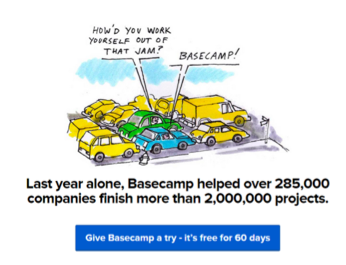Brands
Show, Don’t Sell: How to Use Empathic Marketing to Win More Business in 2018
I think today’s marketing is just a little too obsessed with data. Cue the gasps and snaps and oh no she didn’ts.
At a recent networking event, I was talking to a marketer who’d just gotten married. Given her profession, she wasn’t surprised when her momentous life occasion triggered an onslaught of promos and offers. What she hadn’t prepared for, though, was when brands expected that she’d soon be expecting.
About 10 weeks after the wedding, this woman started receiving coupons from a well-known baby-goods retailer. And she was mad about it—really mad. She wanted kids someday, sure, but she also wanted to enjoy the honeymoon phase of her marriage and continue developing her career. She definitely didn’t want this store up in her business.
It’s not hard to see how we arrived at this point. The brand probably mapped out its touchpoints and discovered through research that a good percentage of couples conceive soon after their weddings. What the data did not account for, however, was the emotions of couples who had no plans to conceive on the same day they smash cake in each other’s faces.
I’m not saying that we shouldn’t use the vast amounts of data at our disposal to make informed decisions. But if we don’t combine facts with people’s feelings, we’ll end up surrendering revenue. (Guess who won’t be going to that baby retailer for future baby shower gifts?)
Over the last few weeks, I’ve been writing about empathic marketing. Since this is the last column in my four-part series, it’s time to look at how we as marketers earn our keep. How do we use empathy to persuade people that our products can solve their pain? How do we take someone from consideration to conversion by being more considerate?
As the just-married marketer can attest, brands have to choose the right moment to make their pitch. Here’s how they can do that in the future.
Look for signs of readiness
Have you ever complained to a friend about something and gotten annoyed when they interrupted with a quick fix for your problem?
Psychologist and California State, Chico professor Dr. Joel Minden has described the impact of interruption as follows: “Not allowing someone to complete a statement conveys messages like, ‘I want you to stop talking’ or ‘What I have to say in this moment is more important than what you’re saying.'” Not only do you feel disrespected, but you’re still stuck mid-kvetch with your pain.

Marketers can be like that overeager friend. We have good intentions! We want to help! We have a solution! But we come in too soon, interrupting our buyer.
Marketers can be like that overeager friend. We have good intentions! We want to help! We have a solution!
So what’s the alternative? Taking the time to read verbal (“I just don’t know what to do”) and visual cues (calmer hands) until you find the perfect moment to pitch. In the book The Marketing Power of Emotion, Columbia University business professor John O’Shaughnessy notes that some researchers believe knowing your customers’ emotions can help you “identify an emotional script that goes from the triggering event to the thought to the feeling to the action.”
O’Shaughnessy argues that this approach is not foolproof, because situational factors also play into decision-making. But this book was written in 2002, well before we had the technology to track situational factors. Seems to me like there is a way to take into account both practical and emotional cues—like “customer visited website three times last week” and “customer was excited on a call with the sales rep”—to determine whether when someone becomes a qualified lead.
Even if you can’t achieve that kind of data harmony yet, you can always conduct research to find out what buyers were feeling in the weeks, days, and moments before they made a purchase or signed a contract. Salespeople, merchandising teams, and account managers can all use your research to improve their timing on promotions or demos.
In the future, technology may provide an additional assist that makes empathic marketing easier. Cutting edge “emotional detection” or “emotional recognition” software is beginning to provide facial (visual), semantic (words), and sonic (speech) sentiment assessments. That sector is poised to grow 40 percent annually and be a $36B market by 2021, according to MarketsandMarkets. Some companies are already using these programs to test ad campaigns, so it seems plausible that one day we’ll use them to test buyer readiness in real time.
Show, don’t sell
Marketers tend to overuse the word “should.” It’s such an easy linguistic trap. If we tell people what they should do, they’ll listen, right? (Anyone who has a child knows this is not true.)
Thanks to my past life as a journalist, I’m extra conscious of the word. Craig Matters, former managing editor at Money, banned staff from using it. He didn’t want our readers to feel like we were being condescending.
There are other reasons not to use the S word. As British life coach Hannah Braime writes, when we use the word, “we are not accepting reality.” We’re trying to spur customers to do something divorced from their current situation.
Braime suggests that her script is more effective when she focuses on the benefits—so instead of “I should go to the gym” make it “I feel really energetic and powerful when I go to the gym.”
In psych terms, this is called the framing effect. It comes out of a study by Nobel-prize-winning behavioral economist Daniel Kahneman. (The study details are fascinating if you have some extra time.) The basic takeaway is that focusing on the benefits helps your argument more than highlighting the cost of not doing something.

Marketers can easily apply that thinking to our calls-to-action. Instead of focusing on the urgency to buy or sign up, test language that speaks to the benefits of what you’re offering. You can see a good example in the image above from project management platform Basecamp. I like that it speaks to both the suffering of the target customer (the inability to get stuff done) as well as how the product contributes to solving the problem.
Empower buyers to make decisions
In “The Art of Giving and Receiving Advice,” Harvard business professors David Garvin and Joshua Margolis make the case that as someone in an adviser position, you want to “think of yourself as a driving instructor. While you provide oversight and guidance, your ultimate goal is to empower the [advice] seeker to act independently.”
That same logic could be applied to marketing. Wouldn’t it be best if your customer arrived at a purchase decision instead of feeling forced into something? Buyers want agency to make their own decisions.
If we don’t combine facts with people’s feelings, we’ll end up surrendering revenue.
So how do you nudge the buyer into an independent decision that’s in your favor? If your business has a high-touch sales process, your bottom-of-funnel stage might include a meeting with the client where you ask how your product compared to other vendors. The salesperson could then share facts about product differentiation (“they have X, but we have Y”) rather than trying to be persuasive (“you’ll be better off with us because…”).
If you’re an e-commerce business that would have difficulty doing this face to face, you could include a chart on your purchase page that compares your product to the competition. (Here’s a great delineation of that strategy from Meagan French, CEO of demand-gen consultancy Lotus Growth.) You could also work this chart into lead generation and sales enablement collateral.
By paying closer attention to the buyer’s journey, you could empower visitors to tell you exactly what it would take to turn them into customers. When someone comes to your site and doesn’t convert, an exit modal might appear that says “We want to be better. Can you tell us why you didn’t make a purchase today?” Then you can send customer service reps or retargeting solutions in to close the deal.
Give something to get something
Not too long ago, a friend teased me after I confessed that I sat through a demo after going to an event the vendor hosted. I was a victim of the psychological concept of reciprocity, which is when we feel compelled to pay back a positive action someone has done for us. In his pivotal book Influence: The Psychology of Persuasion, Dr. Robert Cialdini, professor emeritus of psychology and marketing at Arizona State University, named reciprocity one of the six key principles of influence.
The rule of reciprocity can also be a useful addition to our empathic marketing toolbox. Whether we realize it or not, the process of buying something actually causes us suffering, even if it’s something we really want. Our brains are wired for loss aversion, which means the negative feelings we experience around a loss are greater than the positive feelings that accompany a gain. Every purchase includes a loss since the customer has to part with money.

One easy way to ease the loss aversion would be offering a freebie or freemium option before you present your solution. That could be a personalized report, an initial consult, a 60-day trial, even a dinner at a fancy restaurant. (Slightly concerned that I’m positioning myself for a plethora of dinner invitations.) Keep in mind that it has to be something your customer will perceive as having real value (I value meals at fancy restaurants) rather than useless swag like flash drives and beer koozies. The file-sharing platform WeTransfer is one of my favorite examples of this. By offering something for nothing, the company tells customers they’re worth the short-term loss of revenue that comes from a free option. The user then has time to get hooked on the product. And WeTransfer is setting up the chance for reciprocity. I’m writing about them, aren’t I?
Speaking of the rule of reciprocation… it’s your turn now.
Over the past several weeks, I’ve shared plenty of ideas on how to practice more empathic marketing—some I’ve tried, some I haven’t. I’m definitely not an all-knowing guru. But I am a concerned citizen of marketing who’s frightened of a future in which we talk to humans solely through our marketing stacks.
Thanks for joining me on this journey on empathic marketing. I’d love to practice what I’ve preached for a bit and listen to what you have to say about empathic marketing. Have you tried any of these tricks and found they worked (or not)? Do you have your own strategies that would be valuable for others to know? What are your favorite examples of brands with heart? And most important, what will you do in 2018 to be a more empathic marketer? I’m looking forward to hearing your stories—and strengthening my own empathy muscles along the way.
Margaret Magnarelli is the senior director of marketing and managing editor for content at Monster. This is the fourth and final column in her series on empathic marketing. You can the first, second, and third installments here.
Image by iStockphotoGet better at your job right now.
Read our monthly newsletter to master content marketing. It’s made for marketers, creators, and everyone in between.




